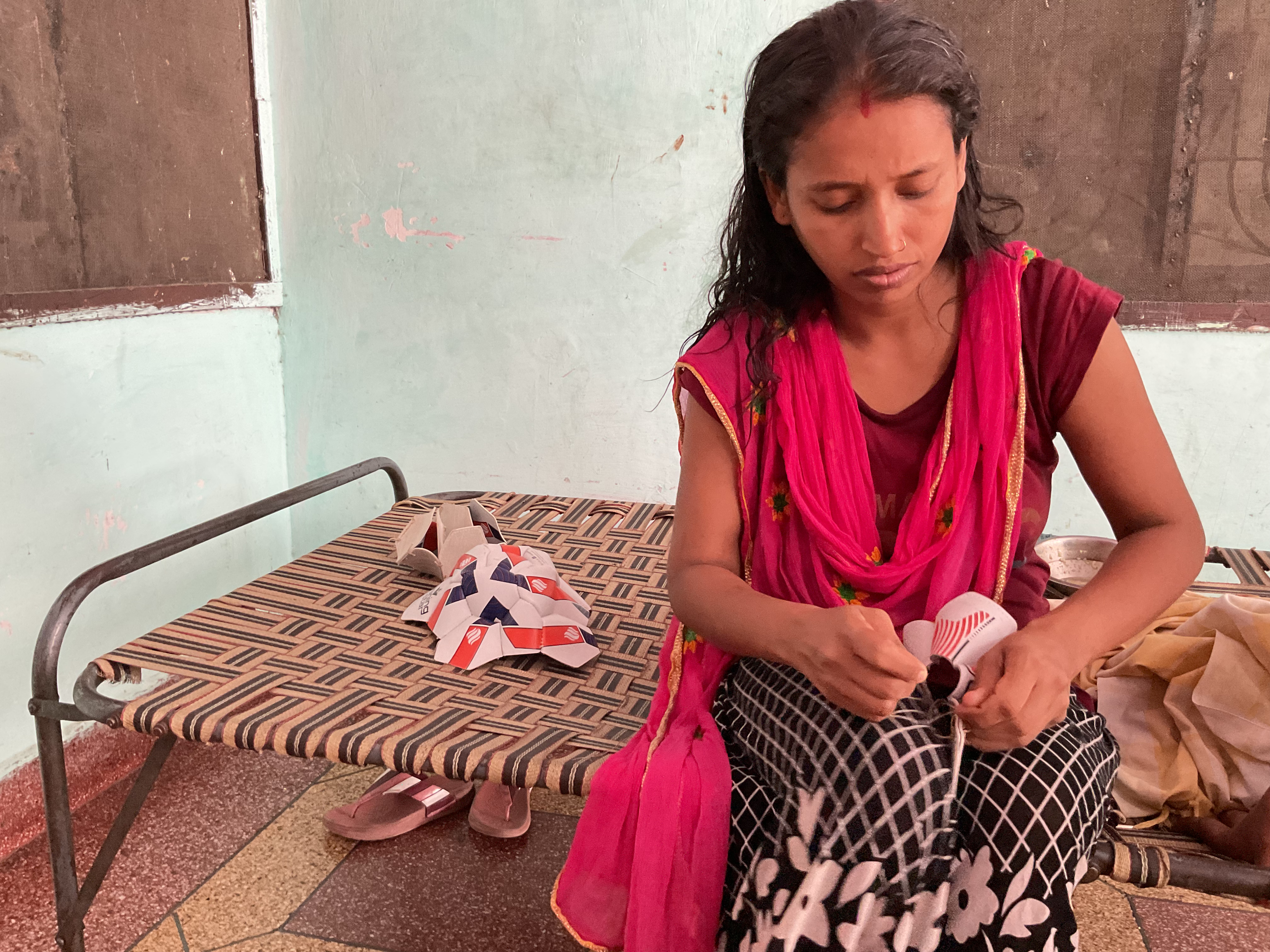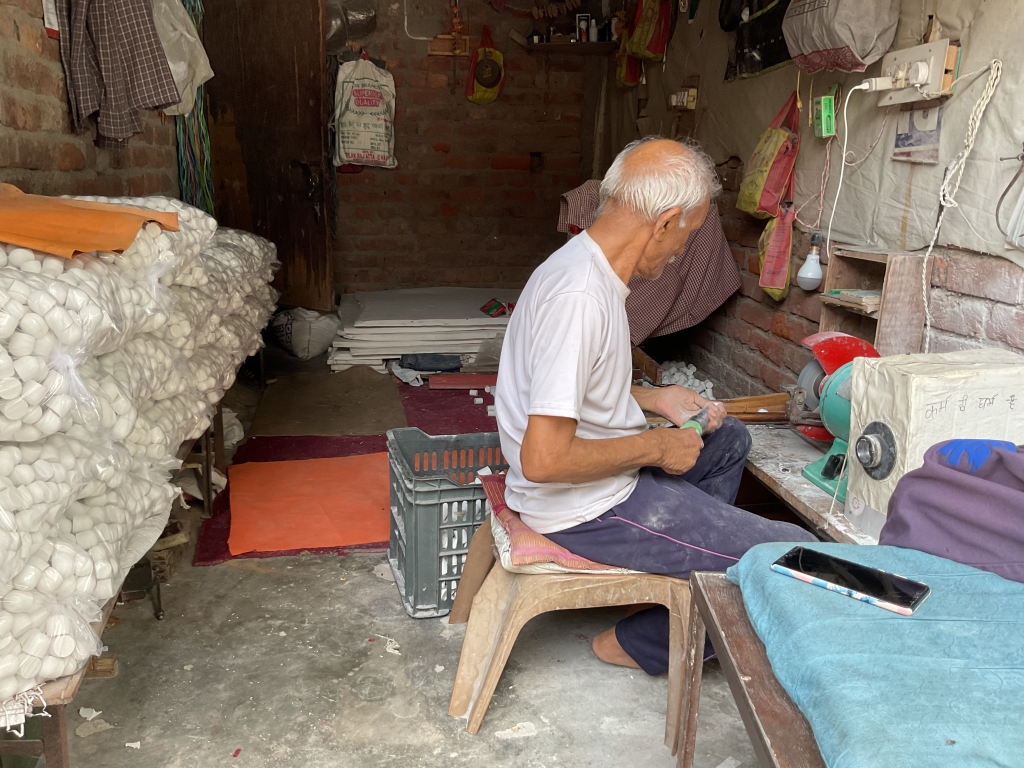Exploitative Wages, Backbreaking Work: The Home Workers Behind Jalandhar’s Mega Sports Goods Industry
Rs 4 to feather a dozen shuttlecocks, Rs 35 to stitch a football, Rs 62 to tack together six panels of a rugby ball – that is what home-based women workers are paid to keep the booming sports good industry of the city in business.
- Anuj Behal

For the last two years, Preeti, 35, has been stitching footballs in her home in Jalandhar’s Bhargav Camp. She earns Rs 35 per ball and manages to stitch three to four in two days. She earns no more than Rs 2500 a month, a fraction of the Rs 15,000 she made in her previous job as a receptionist at a neighboring hospital.
“I worked for a few months after my marriage, but then I had four daughters one after another and I had to leave work to take care of them,” she explained. “Now, this is the best I can do while working from home. Three of my daughters are going to school, and once my youngest one gets admission [to school], I might resume work. Until then, I just manage to save some pin money here and there.”
Preeti’s earnings go mostly into household expenses and small savings. “When I was working as a receptionist, I never had to depend on my husband for personal expenses. Now, it’s different. He never refuses to give me money, but I liked having my own independence to spend on befizul (silly) things.”
This is a common story among the women who do home-based piecework for Jalandhar’s sports goods industry. Home-based work in India has become a crucial source of employment for women, with 17.19 million of them engaged in it in 2017-18, says a 2020 report by Women in Informal Employment: Globalizing and Organizing. By 2011-12, women home-based workers constituted 31.7% of all women employed in non-agricultural work, highlighting the significance and scale of the field.
Jalandhar’s sports industry caters to 55% of the country’s demand for sports goods – the domestic market is worth Rs 1,300 crore and exports worth around Rs 400 crore. For the 2014 FIFA World Cup in Brazil, the city supplied 80,000 soccer balls. As much as 99.7% of the industry is driven by small-scale industrial units, and this is a major source of employment in the city.
Different kinds of inflatable balls make for about 60% of the sports goods manufactured in the city. Badminton racquets and shuttlecocks, cricket bats and balls, various kinds of gloves, sports shoes and protective equipment are other Jalandhar products. The city’s key manufacturing hubs include Basti Danishmanda, Basti Guzan, and Basti Nau.
Of the 60,000 to 70,000 people the industry employs in the city, our investigations showed that many are women home-based workers. While this offers livelihood opportunities to women who are restricted by responsibilities of domestic and care work, it also leaves them underpaid and without any social protection.
Women are an integral part of this industry, taking on much of the tedious repetitive work. But they earn between Rs 1,500 to 7,000 a month, showed our primary survey. This is well below Punjab’s state minimum wage of Rs 10,736.75 for unskilled work.
Rs 4 For Feathering 12 Shuttlecocks
Bachno Devi, 55, who lives and works in Bhargav Camp, has been stitching feathers onto shuttlecocks for the last 30 years. Her task is simple and repetitive: she has to make two lines of stitches to secure 16 feathers on each shuttlecock. For this, she earns Rs 4 per dozen shuttlecocks. Each bundle she receives contains 12 dozen shuttlecocks, and when she finishes the lot she gets Rs 48.

She tries to work through two or three bundles over two days. “Each bundle takes me almost three hours to complete, and taking time off from household chores – even 4-5 hours – is difficult. Sometimes, because of my backache I can only manage one bundle,” she said.
When Bachno started stitching shuttlecocks 30 years ago, she earned just 40 paise per dozen. But all her earnings get used up in household expenses. “I don’t think I’ve ever saved anything from this work,” she said.
Raj Rani, 56, has been stitching rugby balls for a local rubber factory for over 40 years in Basti Danishmanda. The work is supplied by a local contractor, who pays her Rs 62 per rugby ball. She receives around eight balls each day. “Earlier, I could finish ten; now I can only manage five or six,” she said.
It is painstaking work – each rugby ball requires six panels to be stitched together, and this involves working with needles in both hands to make cross stitches. Every ball takes about one and a half hours of this work. The work is also erratic, Raj Rani complained, and at most she gets 16-18 days of work each month. The demand for labour is steady only in peak season or during sports events when demand surges.
Raj Rani also has to buy the raw material – thread, needles, and wax for polishing the edges of the rugby balls before stitching. Thread costs around Rs 175 a kg and it needs to be made pointed to pass through the thin needles. Despite all these additional expenses, she earns between Rs 5,000 and 8,000 a month if she works 6-7 hours a day.
Pieces get rejected too and this means money deducted or demand for changes in the product. Even when the rubber is defective or worn out, the responsibility of a flawed ball falls on the worker.
Raj Rani starts her day at 6 am, finishes her household chores including cooking lunch and breakfast for her family of three by around 10am. She starts working on the balls immediately and takes a break for lunch at 2-2:30 pm when her husband returns home from the factory. She resumes work at 4 pm and continues for three hours, and then it is time to organise dinner. After the last meal of the day, she works for an hour or two to meet her daily target.
It is a relentless cycle of labour, paid and unpaid, without any rest or leisure time. “There are days when I do not even get to step out of the gate of my house for some fresh air. I step out of the house mostly to buy the raw material. But that too is often done by my son when he comes home from work,” she said.
The wages remain low no matter what the nature of the work. For instance, women who do the work of boring holes on shuttlecocks are paid Rs 25 for drilling 16 holes in a packet of corks, containing 60 dozen (720). The women have installed boring machines in their homes, which cost them around Rs 5,000 to Rs 6,000. “It’s difficult to get two packets done in a day, and we prefer not to push ourselves beyond that,” one of them told us.
Gendered Wage Difference
A shuttlecock that sells for Rs 20 in the market nets the worker who makes it less than Rs 1. Ravi Kumar, 36, owns a small workshop in Bhargav Camp, supplying work to women like Bachno. When asked about the minimal wages the women earn, he countered that his slim profit margins are very slim.
“If we pay these women Rs 4 per dozen, we sell it at Rs 16-18 per dozen, making a profit of just Rs 7-8. A kilo of feathers costs Rs 450 and yields around 15 dozen shuttles. There’s a lot of wastage and cutting involved, and we also have to wash these feathers,” he said.
Ravi Kumar explained the long chain of tasks involved in making a shuttlecock. First, the base is shaped out of malleable foam like sheets and then another worker steps in and drills 16 holes in it. A third worker then cuts the feathers and arranges them in the holes. A fourth person, often a woman, stitches the feathers together. Finally, the last worker in the chain polishes the products and attaches the brand sticker on the shuttlecock.

“The tasks assigned to each person are strictly gendered, with women typically tasked only with stitching feathers and boring holes in the cocks,” Ravi explained. “Women excel at this, and they are tasks that require minimal skill. Cutting, attaching feathers, and shaping corks are skilled jobs suitable only for men.”
This ambiguous classification of skilled versus unskilled work, and the perception that women cannot learn these tasks as quickly as men, results in significant wage disparities. Male workers who shape the shuttlecock corks using their own foam sheets earn Rs 375 per packet, while women who bore holes in the same packets earn just Rs 25.
Similarly, attaching feathers to the punched holes, primarily a task performed by men, is compensated with a monthly wage of Rs 12,000 to Rs 15,000 at workshops like Ravi’s.
According to the International Labour Organization, women tend to be overrepresented in occupations perceived as unskilled and of “low value“. Despite some progress, globally, women earn an average of just two-thirds of men’s wages.
Worsening Eyesight, Aches
Home-based workers, despite their significant contributions to the domestic economy, find themselves without access to training, safety equipment, or social security. They remain unrecognised by both companies and the government alike.
Raj Rani explained the business of it: “It’s the contractor who gives us the assignments, not the factory. Because if it did, it would have to make us permanent employees and they would have to issue factory cards. This contract work only makes things worse for us laborers. We are stuck with piece rates.”
The long hours of work have taken a toll on Raj Rani’s health. By the end of the day her knees ache, back hurts and eyes strain. “Even my finger joints ache,” she said. She straps tight leather rings on her fingers to prevent the thread from cutting into her skin. She also mentions occasional irritation from inhaling the smell of the rubber.
Bachno said her eyesight has worsened over time. “This work requires focused eyesight, which I feel I’m losing day by day,” she said.
Raj Rani has been making rugby balls for the same firm for the last 25 years but it does not extend her any kind of health insurance. Despite a clear reduction in productivity over the years, she has continued working because the income is essential. “Once we stop working, nobody will pay us,” she pointed out.
Work At Home Never Counts
Preeti, who has been stitching footballs for the last three years, never considered negotiating the piece rate with her contractor. “This work is a time-pass for me until I resume full-time work. It’s fine whatever I get sitting at home,” she said.
Home based work is undervalued by the industry, society, families and the women themselves, pointed out Shalini Sinha, India Country Representative at Women in Informal Employment: Globalizing and Organizing (WIEGO), a network of organisations working for the rights of women informal workers in South Asia. “Patriarchy reinforces the notion that women only work in their free time, but if you count the hours, it’s significant hours a day. Minimum wages are never considered. Part of the issue is the isolation in which the work is done; nobody knows what others are earning,” she said.
She said the women never negotiate for better money because “if they don’t do it, someone else will. They just think they are lucky to get the work rather than recognizing that they are highly skilled.” Counting themselves as non-workers further deprives these women of worker rights such as minimum wage laws, contracts, better working conditions and hours and the right to unionise.
There are two reasons for this work being considered ‘faltu ka kaam (worthless work)’, according to Shalini Sinha: “It’s a sector dominated by women, and the work is being done at home. And work is associated with its ‘place.’ A place of work is a factory, office, or even outdoors as in vending. But economic work done by women at home, this combination is never acknowledged as work.”

She said the women never negotiate for better money because “if they don’t do it, someone else will. They just think they are lucky to get the work rather than recognizing that they are highly skilled.” Counting themselves as non-workers further deprives these women of worker rights such as minimum wage laws, contracts, better working conditions and hours and the right to unionise.
There are two reasons for this work being considered ‘faltu ka kaam (worthless work)’, according to Shalini Sinha: “It’s a sector dominated by women, and the work is being done at home. And work is associated with its ‘place.’ A place of work is a factory, office, or even outdoors as in vending. But economic work done by women at home, this combination is never acknowledged as work.”
She pointed out that not only does this work not get classified as economically productive, it is also not seen as contributing to the family’s finances. “Secondly, it is counted as a part of women’s care work duties at home.”
For these workers to unionise means addressing both the exploitation inherent in the production structure and the women’s own anxieties about stepping out of their familiar, albeit patriarchal, home environment.
Raj Rani fears that if she joins a union or demands better pay, she’ll lose her job. “The factory owners hold all the power and they fund the local councillors. If a councillor wins with the factory owners’ money, why would they advocate for workers’ rights instead of protecting the factory owners?”
She is 60 now but retirement is not an option. “I don’t know how much longer I can keep this up,” she said.
We believe everyone deserves equal access to accurate news. Support from our readers enables us to keep our journalism open and free for everyone, all over the world.

